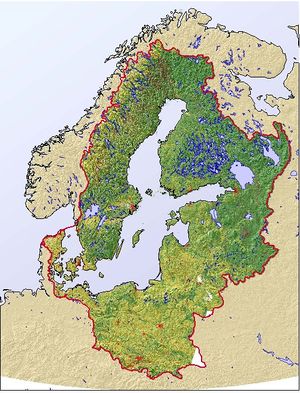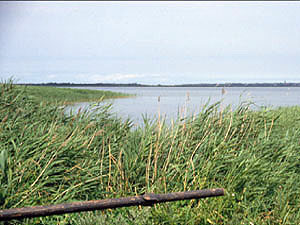Baltic Sea
From Coastal Wiki
Contents
Local environment
Definition and basic facts

Figure 1:Baltic Sea and its Drainage area[1]
| Parameter | Measure |
|---|---|
| Area | 415 000km2 |
| Length | 1300 km |
| Width | 1200km |
| Maximum depth | 459m |
| Sill depth | 17m |
| Residence time of water | 25yr |
Specific biodiversity issues
The flora and fauna of the Baltic is unusual in that there are areas in which freshwater, brackish water and marine species co-exist. For example, the freshwater plant Phragmites spp. and the marine wrack Fucus spp. can be found side by side. The Baltic Sea has existed for a relatively short time period and has undergone major changes; subsequently it contains a very limited brackish-water flora and fauna. The area is characterised by low species diversity, but many individuals of each species.
Threats
Many of the marine species present are at the limit of their biogeographical distribution. The highest biodiversity is found in the southwest of the Baltic Sea. The major threats to marine biodiversity in the region are unsustainable exploitation of fisheries resources, eutrophication (enrichment from plant nutrient, reducing oxygen levels), pollution from contaminants and oil and the introduction of alien species.
References
- ↑ http://maps.grida.no/go/graphic/land_cover_baltic_sea_region_ balans
- ↑ Bonsdorff, E., C. Ronnberg & K. Arnio, 2002, Some ecological properties in relation to eutrophication in the Baltic Sea. Hydrobiologia 475/476, pp 371-377
See also
- Baltic Marine Environment Protection Commission (Helsinki Convention)
- An exercise in comparing the pelagic and benthic macrofauna species diversity in Arctic, Antarctic and Baltic sites using the taxonomic distinctiveness index [1]
- Values of, and threats to, marine and coastal habitats in the southern Baltic [2]
- Shallow sandy sublittoral: the ecological treasure of the southern Baltic Sea [3]
- Daily sea surface temperatures rom the late 1800s to the early 2000s implications for biodiversity in the Baltic Sea [4]
- Application of benthic indices to assess biodiversity in the southern Baltic Sea [5]
Please note that others may also have edited the contents of this article.
|
